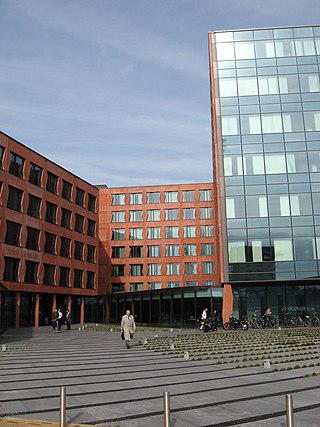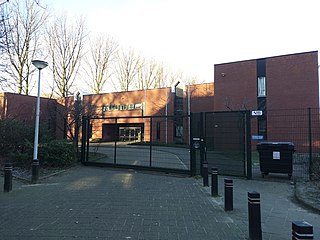Related Research Articles

Rotterdam is the second-largest city in the Netherlands after the national capital of Amsterdam. It is in the province of South Holland, part of the North Sea mouth of the Rhine–Meuse–Scheldt delta, via the "New Meuse" inland shipping channel, dug to connect to the Meuse at first and now to the Rhine.

The Hague is the capital city of the South Holland province of the Netherlands. With a population of over half a million, it is the third-largest city in the Netherlands. Situated on the west coast facing the North Sea, The Hague is the country's administrative centre and its seat of government, and while the official capital of the Netherlands is Amsterdam, The Hague has been described as the country's de facto capital since the time of the Dutch Republic.

Demographic features of the population of the Netherlands include population density, ethnicity, education level, health of the population, economic status, religious affiliations and other aspects of the population.

Statistics Netherlands, founded in 1899, is a Dutch governmental institution that gathers statistical information about the Netherlands. In Dutch it is known as the Centraal Bureau voor de Statistiek, often abbreviated to CBS. It is located in The Hague and Heerlen. Since 3 January 2004, Statistics Netherlands has been an independent public body, or quango. Its independent legal status enables the reliable collection and dissemination of information to support public debate, policy development and decision-making.

Den Haag Centraal is the largest railway station in the city of The Hague in South Holland, Netherlands, and with twelve tracks, the largest terminal station in the Netherlands. The railway station opened in 1973, adjacent to its predecessor: Den Haag Staatsspoor, which was subsequently demolished. It is the western terminus of the Gouda–Den Haag railway.
Koreans in France numbered 29,367 individuals as of 2014, making them the 3rd-largest Korean diaspora community in Western Europe, according to South Korea's Ministry of Foreign Affairs and Trade.
Child laundering is a tactic used in illegal or fraudulent international adoptions. It may involve child trafficking and child acquisition through payment, deceit or force. The children may then be held in sham orphanages while formal adoption processes are used to send them to adoptive parents in another country.

Inholland University of Applied Sciences is a large university of applied sciences located in eight main cities of the Randstad, the central-western region of the Netherlands and the country's economic, political and cultural hub. With over 37,000 students from more than 100 countries, the university follows the applied sciences mode of education.
Cape Verdeans in the Netherlands consist of migrants from Cape Verde to the Netherlands and their descendants. As of 2022, figures from Statistics Netherlands showed 23,150 people of Cape Verdean origin in the Netherlands.
Filipinos in the Netherlands comprise migrants from the Philippines to the Netherlands and their descendants living there. According to Dutch government statistics, 16,719 persons of first or second-generation Philippine background lived in the Netherlands in 2011. Though Filipinos live throughout the country, Amsterdam and Rotterdam are homes to the largest Filipino communities.
Moroccans in the Netherlands are Dutch citizens of Moroccan origin. They consist of immigrants from Morocco and their descendants, and form the second largest ethnic group in the Netherlands.
Dutch Pakistanis formed a population of 27,261 individuals according to the latest official statistics published by the Netherlands Centraal Bureau voor de Statistiek on 1 January 2022.

Japanese people in the Netherlands include expatriates from Japan and their descendants, as well as Dutch citizens of Japanese ancestry.

Rotterdam Centraal station is the main railway station of the city Rotterdam in South Holland, Netherlands. The station received an average of 112,000 passengers daily in 2019. The current station building, located at Station Square, was officially opened in March 2014.
Chinese people in the Netherlands form one of the largest overseas Chinese populations in continental Europe. In 2018 official statistics showed 92,644 people originating from the People's Republic of China (PRC) and Republic of China (ROC), or people with at least one such parent. However, these statistics do not capture the whole size of the Chinese community, which since its earliest days has included not just migrants from China, but people of Chinese ethnicity drawn from among overseas Chinese communities as well.
Vietnamese people in the Netherlands form one of the smaller overseas Vietnamese communities of Europe. They consist largely of refugees from the former South Vietnam, Vietnamese born-citizens and their descendants.
Iranians in the Netherlands form one of the newer and larger populations of the Iranian diaspora in Europe. Iranians in the Netherlands are referred to by hyphenated terms such as Dutch-Iranians, Iranian-Dutch, Dutch-Persian, or Persian-Dutch. Similar terms Iraanse Nederlanders, Nederlandse Iraniërs, and Perzische-Nederlanders may be found in Dutch-language media.
Dutch Afghans are Dutch citizens and non-citizen residents born in, or with ancestors from, Afghanistan. In 2015 there were 44,000 Dutch Afghans, which form one of the largest Afghan diaspora communities as well as one of the main Asian communities in the Netherlands. Most of the first generation population originally settled in the Netherlands between 1992 and 2001.
There is a small population of Angolans in the Netherlands numbering around 10,000 people, largely consisting of refugees from the Angolan Civil War.
Nepalese in the Netherlands consists of immigrants, expatriates and international students from Nepal to the Netherlands as well as Dutch people of Nepalese origin. As of 2010, statistics of the Dutch Centraal Bureau voor de Statistiek shows that there are about 1,505 people of Nepalese origin living in the country.
References
- "Korean Language School: Informal", Overseas Korean Educational Institutions, South Korea: National Institute for International Education Development, 2004, archived from the original on 2006-11-18, retrieved 2010-05-03
- Country Education Profile: South Korea (PDF), The Hague: Netherlands Organization for International Cooperation in Higher Education (NUFFIC), September 2009, retrieved 2010-05-03[ permanent dead link ]
- Population by origin and generation, 1 January, The Hague: Centraal Bureau voor de Statistiek, 2012, retrieved 2012-12-17
- 재외동포 본문(지역별 상세), Ministry of Foreign Affairs and Trade, 2011-07-15, retrieved 2012-02-25
